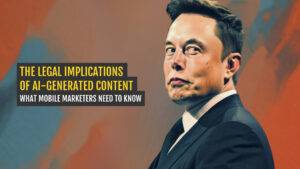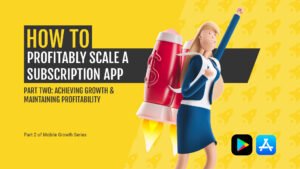Subscribe to Mobile Artificial Insights – a weekly LinkedIn newsletter where we explore the practical applications of AI tools in every aspect of mobile marketing.
If you’ve spent any time on the internet in the last three months, you know that artificial intelligence (AI) has been making waves in almost every industry imaginable–from medicine to social media and everything in between.
Mobile marketing is no exception to this technological explosion, with generative AI tools like Midjourney and DALL-E 2 already being used to create mobile game characters and app store icons.
We recently held a webinar where AppAgent’s CEO Peter Fodor and Creative Producer Marty Skopalik discussed the practical applications of AI tools in mobile marketing. Throughout the session, we invited viewers to ask questions via live chat. Surprisingly (or maybe not so surprisingly), many of the questions we received were related to the legal aspects of using generative AI for creative purposes.

As we struggled to answer these complex legal questions on the spot, we realized the need for an expert’s opinion. Below is our conversation with Pavel Cech of Sedlakova Legal, who was able to shed some light on the legal implications of using AI for creative purposes.
Q. Under current intellectual property laws, what are the legal guidelines regarding claiming ownership of AI-generated works, such as text, music, and visuals? Can individuals or organizations hold rights over such creations?
First of all, it’s necessary to determine whether AI-generated works are eligible for copyright protection. And the most important question is: who would be the author?
There are a few possible answers to this:
- The AI itself as the author, in which case the AI owner would have the copyright.
- The AI model’s human programmer as the author, in which case the programmer would have the copyright.
- Persons that prepared the AI model’s training data as the author, in which case they would have the copyright.
- Persons using AI to create a work (AKA who sets the outputs parameters) as the author, in which case they would have the copyright.
Because of this, the ownership of AI-generated work is very disputable and may vary from country to country. In the United States for instance, “an image generated through artificial intelligence lacks the ‘human authorship’ necessary for protection”.
The European Commission proposed a “four-step test” in its report on AI-related IP. According to this, in order for an AI output to qualify as “work”, it must include human intellectual effort.
Therefore, it is safe to assume that in most jurisdictions, if the work has been created entirely by AI, it will not be eligible for copyright protection.
However, when it comes to AI-generated artwork that has a significant amount of human input, there are ongoing cases in which human authors may become eligible to receive copyright protection and serve as a precedent.
In practice, it’s most important to review the Terms of Use of the tool you used to generate the content. These terms may specify whether the user or the service provider retains the right to use the content generated by AI for its own purposes. In this case, we don’t have to deal with theoretical discussions, as the service provider will resolve it for us.
Q. In the context of advertising, if a famous actor’s photo or voice is regenerated through the use of AI to create an artistic variation, what legal considerations should be considered before using such a creation, and what factors may affect the permissibility of such use?
A person’s identity and personality, including their voice and resemblance, are protected by privacy laws. Unless a specific exemption applies, you can only capture and reproduce a person’s identity with their consent.
Exemptions may include news reporting, scientific use, or legitimate interest (for example, using cameras to protect your property). But in the case of advertising, there usually won’t be any exemptions.
So, if you regenerate a famous actor’s photo or voice through AI, it may therefore be an unauthorized interference with their identity and personality. This may further result in a civil lawsuit and, if the damage caused is serious, may also be prosecuted as a criminal offense. This would be the case for deepfakes used to spread panic, such as someone intentionally recreating the voice of a politician to make it appear as if they said something untrue.

Q. What are the legalities surrounding the use of AI, particularly in regard to ownership of AI-generated creations? What should companies consider when researching these legal issues, given the potential risks and ongoing lawsuits related to the use of AI technology?
Bearing in mind the currently tentative status of AI-generated works, companies should consider the fact that once they use a creation made with AI, they are somewhat losing the possibility to control the legal status of the generated works.
In addition, it’s very difficult to determine to what extent the creation contains or was inspired by works that are protected under copyright law.
For example, if you hire a graphic designer to create a logo for your company, you can specify in the contract that the contractor is responsible for any infringement of third-party rights. And should something go wrong, the contractor will be liable for the infringement. But in the case of an AI tool, the provider usually waives any responsibility for the use of its creations. So should any such creation infringe on third-party rights, you will not be reimbursed by the service provider.
It’s also important to look at the Terms and Conditions (see the excerpt at the end of this article*) of the AI software with regard to license provisions. Some services require purchasing higher tiers of subscriptions to use the generated content for commercial purposes. And as the technology advances, you can be sure that sooner or later, all AI-generated outputs will contain metadata about their creation. Therefore, identifying that you breached the license may be easier than you think.
Q. Tools like Midjourney are basically creating compilations of preexisting artworks, which can sometimes be very similar to the original works. How can this be considered legally distinct from plagiarism and what factors would be considered in such a determination?
Since tools like Midjourney generate outputs based on original artworks with very little user input, the line between plagiarism and inspiration may be very thin. Additionally, the standards necessary to determine what’s considered plagiarism may differ for each state depending on its copyright and case laws.
The European Directive 2019/790 and its transposition to member states currently favors the use of such AI tools. The directive allows data mining as an exception to copyright and database protection. It states that unless the original author of texts and data expressly reserves such use, it is allowed to make reproductions and extractions of texts and data. Therefore, using this data to create an AI model is allowed.
However, the question of creating compilations remains unanswered. Therefore it is advisable to design the AI model in such a way that the outputs are only inspired by the formulas and styles of preexisting artwork expression while copying it as little as possible.
Q. Similarly, are there any legal concerns related to the use of artistic styles, such as Van Gogh’s painting style, in the creation of new work?
According to some opinions, artists may seek protection under the laws on unfair competition, as copying their style may be viewed as free-riding on reputation–which is an abusive competitive practice.
Nevertheless, specific artistic styles on their own are not copyright protected. This is the same as with ideas, procedures, and formulas. Copyright protection is bound only by the work itself.

Final Thoughts
The use of AI in mobile marketing has opened up many new possibilities, particularly in the area of creative content generation. However, there are legal issues surrounding the ownership and protection of AI-generated works that must be carefully considered by individuals and organizations before using such creations.
When using AI in your creative production process, it’s crucial to review the Terms of Use of the tool you use, as well as the relevant intellectual property laws in your jurisdiction. In addition, the use of AI technology may present potential risks and ongoing lawsuits, so it’s essential to be mindful of these issues when doing your research.
Ultimately, while AI technology can be a powerful tool in mobile marketing, it’s important to approach its use with caution and a deep understanding of the legal implications involved.
Still want to add a human touch to your ad creatives? We can help you with that!
*Terms of Use
Below are a few selected passages from the Terms of Use/Service of some widely used AI tools. It’s worth noting that these excerpts are only a small part of the softwares’ terms and conditions. Therefore, we highly recommend that you read the complete Terms of Use or Service of each tool before incorporating them into your creative production workflow.
OpenAI
Restrictions. You may not (i) use the Services in a way that infringes, misappropriates or violates any person’s rights; (ii) reverse assemble, reverse compile, decompile, translate or otherwise attempt to discover the source code or underlying components of models, algorithms, and systems of the Services (except to the extent such restrictions are contrary to applicable law); (iii) use output from the Services to develop models that compete with OpenAI; (iv) except as permitted through the API, use any automated or programmatic method to extract data or output from the Services, including scraping, web harvesting, or web data extraction; (v) represent that output from the Services was human-generated when it is not or otherwise violate our Usage Policies; (vii) buy, sell, or transfer API keys without our prior consent; or (viii) if you are using the API in connection with a website or application directed at children, send us any personal information of children under 13 or the applicable age of digital consent. You will comply with any rate limits and other requirements in our documentation. You may use Services only in geographies currently supported by OpenAI.
Your Content. You may provide input to the Services (“Input”), and receive output generated and returned by the Services based on the Input (“Output”). Input and Output are collectively “Content.” As between the parties and to the extent permitted by applicable law, you own all Input. Subject to your compliance with these Terms, OpenAI hereby assigns to you all its right, title and interest in and to Output. This means you can use Content for any purpose, including commercial purposes such as sale or publication, if you comply with these Terms. OpenAI may use Content to provide and maintain the Services, comply with applicable law, and enforce our policies. You are responsible for Content, including for ensuring that it does not violate any applicable law or these Terms.
Midjourney
Rights You give to Midjourney
By using the Services, You grant to Midjourney, its successors, and assigns a perpetual, worldwide, non-exclusive, sublicensable no-charge, royalty-free, irrevocable copyright license to reproduce, prepare Derivative Works of, publicly display, publicly perform, sublicense, and distribute text, and image prompts You input into the Services, or Assets produced by the service at Your direction. This license survives termination of this Agreement by any party, for any reason.
Your Rights
Subject to the above license, You own all Assets You create with the Services, to the extent possible under current law. This excludes upscaling the images of others, which images remain owned by the original Asset creators. Midjourney makes no representations or warranties with respect to the current law that might apply to You. Please consult Your own lawyer if You want more information about the state of current law in Your jurisdiction. Your ownership of the Assets you created persists even if in subsequent months You downgrade or cancel Your membership. However, You do not own the Assets if You fall under the exceptions below.
If You are an employee or owner of a company with more than $1,000,000 USD a year in gross revenue and You are using the Services on behalf of Your employer, You must purchase a “Pro” membership for every individual accessing the Services on Your behalf in order to own Assets You create. If You are not sure whether Your use qualifies as on behalf of Your employer, please assume it does.
If You are not a Paid Member, You don’t own the Assets You create. Instead, Midjourney grants You a license to the Assets under the Creative Commons Noncommercial 4.0 Attribution International License (the “Asset License”).
If You purchased the Stealth feature as part of Your “Pro” subscription or through the previously available add-on, we agree to make best efforts not to publish any Assets You make in any situation where you have engaged stealth mode in the Services.
Stability.ai
DMCA Copyright Infringement Notice
We have implemented the procedures described in the Digital Millennium Copyright Act of 1998 (“DMCA”), 17 U.S.C. § 512, regarding the reporting of alleged copyright infringement and the removal of or disabling access to the infringing material. If you have a good faith belief that copyrighted material on the Site is being used in a way that infringes the copyright over which you are authorised to act, you may make a Notice of Infringing Material.
Before serving a Notice of Infringing Material, you may wish to contact a lawyer to better understand your rights and obligations under the DMCA and other applicable laws. For example, if your Notice fails to comply with all requirements of sections 512(c)(3), your Notice may not be effective.
MOBILE ARTIFICIAL INSIGHTS
LINKEDIN NEWSLETTER
1K subscribers from companies like Rovio, Red Bull, Huuuge Games, & Snap Inc.

About Pavel Cech
Pavel is a lawyer with a keen focus on the intricacies of IT and software law. His fascination with technology and science fiction started during his childhood, but it wasn’t until his college years that he became aware of the complex legal and ethical challenges involved in bringing these concepts to life. As a founding member of Brno Legal Hackers, a forward-thinking organization dedicated to addressing the intersection of law and technology, he is constantly seeking innovative solutions to current issues in the field. At Sedlakova Legal, Pavel concentrates on software and IT law, including contract drafting, IT law training, and electronic legal negotiations.
Keep up with appagent
📕 Learn more about industry insights and best practices by signing up for our newsletter.
🤝 Get help with growth strategy, app marketing, user acquisition and video ad production by contacting us at hi@appagent.com.
👉 Follow us on LinkedIn, Twitter, YouTube, TikTok, Facebook, and Instagram.
👥 Join our team as a Creative Strategist, Motion Designer, or Art Director.
RELATED ARTICLES










